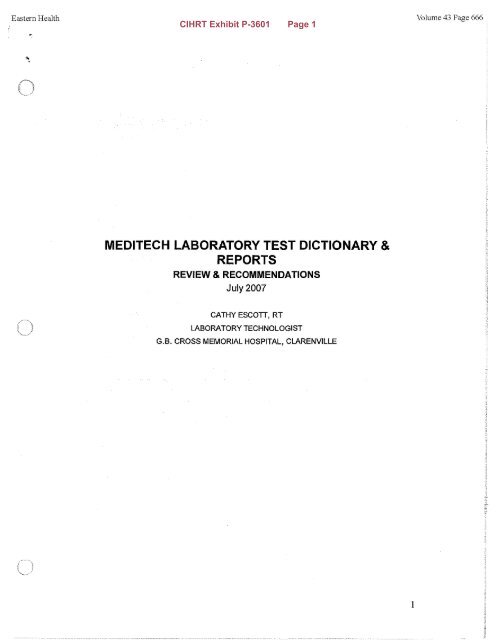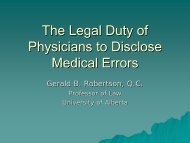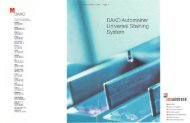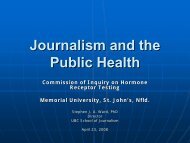MEDITECH LABORATORY TEST DICTIONARY & REPORTS
MEDITECH LABORATORY TEST DICTIONARY & REPORTS
MEDITECH LABORATORY TEST DICTIONARY & REPORTS
- No tags were found...
You also want an ePaper? Increase the reach of your titles
YUMPU automatically turns print PDFs into web optimized ePapers that Google loves.
Eastern HealthCIHRT Exhibit P-3601 Page 1Volume 43 Page 666<strong>MEDITECH</strong> <strong>LABORATORY</strong> <strong>TEST</strong> <strong>DICTIONARY</strong> &<strong>REPORTS</strong>REVIEW & RECOMMENDATIONSJuly 2007CATHY ESCOTT, RT<strong>LABORATORY</strong> TECHNOLOGISTG.B. CROSS MEMORIAL HOSPITAL, CLARENVILLE1
Eastern HealthCIHRT Exhibit P-3601 Page 2Volume 43 PagePan-Canadian Laboratory Observation Code Database(pCLOCD)pCLOCD, a Canadian adaptation of the LOINC® database will be used to maplab orders and results to the Jurisdictional LIS (JLlS) to become part of theInteroperable Electronic Health Record (iEHR). pCLOCD was reviewed for thisreport and the following conclusions have been made:1. Suggested mnemonics are not part of pCLOCD at this time. The namingconventions were considered for the proposed mnemonic developmentguidelines.2. Although pCLOCD contains some order codes for panels, routinechemistry panels are not available at this time. Therefore an assumptioncan be made that the tests within the panels can be mapped to the JLlSbut the panel name will not be available when looking up reports in theJLlS.3. The pan-Canadian display name is algorithmically-generated usingLOINC® elements such as SYSTEM (specimen type), PROPERTY(distinguishes different quantities of same substance), METHOD_TYP(distinguishes analytes measured by different methods) andTIME_ASPCT. Each LOINC® element is separated by a semicolon.Literature indicates that the display name would be primarily used as thereport name seen in the JLlS web viewer. Therefore, for continuity, itwould make sense to have the display name as the test report name inMeditech; however there are a couple of issues with this that should bediscussed by key stakeholders as follows:a. Concatenation of the display name may be required. Some displaynames contain more than the 30 characters available in the longreport name field in Meditech therefore they would need to beshortened and would not match the name in the JLlS web viewer.b. In some cases augmentation of the display name may be requiredto give enough information about the test. At present the specimentype (system) urine is not part of the display name if it is not anunusual specimen for the analyte. The assumption is that thespecimen type would be available in another field in the JLlS webviewer however the test name on the report would require thisinformation.c. The elements of the display name are separated by a semicolonand in some cases contain more information than report namesused at present. This may cause some confusion to personsreceiving reports and some educational materials may need to bedeveloped and distributed.2
Eastern HealthCIHRT Exhibit P-3601 Page 3Volume 43 Page 668REGIONAL <strong>TEST</strong> <strong>DICTIONARY</strong> RECOMMENDATIONS<strong>DICTIONARY</strong> COMPARISONMeditech lab mnemonics for Eastern Health St.John's, Eastern Health Avalonand Eastern Health Peninsulas have been reviewed and in many cases found tohave 3 different mnemonics for the same test. Creating a listed comparison ofthe mnemonics is complicated by the extensive use of other mnemonicsthroughout the 3 systems and I don't think this list would be of any value. I wouldrecommend that a test dictionary clean up be performed by each region usingguidelines provided. Once the cleanup is complete the creation of the followingreports would expedite the creation of a regional lab dictionary as well as themapping of test codes to pCLOCO.1. pCLOCO codes laboratory tests using 6 different characteristics therefore itis possible to have the same laboratory test with 2 different codes that wouldneed to have different mnemonics in Meditech. To facilitate creating aregional lab test dictionary and to provide the tools necessary to map teststo pCLOCO it is recommended that a list of tests for each laboratory section(Le. chemistry, haematology) in each region be developed that wouldinclude the following information some of which could be downloaded to anexcel sheet using NPR.• Common term (Y/N)• Name• Report name• Normal range• Units of measure• Meditech method• Property measured (pCLOCO character-table A)2. Although some panel/group type test are standardized common terms (Le.CBC) many panel/group type tests are used for ease of ordering and can berelated to a specific physician, clinic etc. making them difficult tostandardize. Therefore a list of panel and group type tests including theindividual tests contained in each needs to be created for each Meditechsystem so they can be discussed and evaluated to determine how and ifthey can be standardized. It should also be noted that many of these panelsare not in pCLOCO and therefore the panel name will not appear in the JUSweb viewer. The name of group type tests do not appear on reports andsome consideration should be given to weather or not some panels shouldbe changed to group type tests.OTHER DICTIONARIESThe following other dictionaries linked to the test dictionary should be evaluatedand discussed by key stakeholders to determine if mnemonics should bestandardized.> Methods> Barcode symbologies and label formats.> Container mnemonics3
Eastern Health Volume 43 Page 669CIHRT Exhibit P-3601 Page 4}- Workload codes and functions}- Billing codesRECOMMENDED MNEMONIC DEVELOPMENT GUIDELINES}- Common terms may be used, eg.. PT for Prothrombin Time.}- For ease of lookup and ordering, a mnemonic should contain upper caseletters and not begin with a number or symbol.}- Lab tests that begin with a number or are associated with a time shouldhave the number or time at the end rather than the beginning of themnemonic l.e.17 Hydroxyprogesterone =HYDRPR17 or 2 Hour Glucose =GLUCOS2H.}- Antibody type tests should not begin with Anti or an abbreviation of Antiand should end with AS}- Prefix tests only orderable as part of a panel with ZZ so they are notavailable in general test population on lookup.}- Test name and abbreviations should be entered using upper case letters.}- Create mnemonics using the following formula:• Test names containing 1 word1 First 6 letters of test name.2 If developed mnemonic is already in use add subsequentletters until the mnemonic is unique.3 When developing mnemonics for a 1 word tests prefaced witha word that is used in several other test names where thesecond half of the word is needed to effectively represent thetest use the 2 word guidelines l.e.17 Hydroxyprogesterone =HYDRPR17.• Tests names containing 2 words1 4 letters of first word and 2 letters of second word.2 If developed mnemonic is already in use add subsequentletters from the second word until the mnemonic is unique.• Test names containing 3 or more words1 4 letters of first word, 2 letters of second word, 2 letters ofthird word and 1 letter of any subsequent words.2 If developed mnemonic is already in use add subsequentletters from the last word until the mnemonic is unique.4
Eastern HealthCIHRT Exhibit P-3601 Page 5Volume 43 Page 670COORDINATING CHANGING MNEMONICS<strong>DICTIONARY</strong> LINKSChanging tests mnemonics in a live system will require coordination with otherdepartments as well as other facilities if linked by Medinet. Order Entry labmnemonics will have to be mapped to the new laboratory mnemonics as they arechanged. Medinet order and result codes will also have to be changed to reflectthe new test mnemonic. Some testing with Medinet needs to be done todetermine if tests already ordered but not yet resulted will be affected. There areother dictionaries within Meditech that may be affected as well. The followingtable illustrates possible mnemonic links:Possible Dictionary Update RequiresLinks Automatically user CommentsInterventionOE ProcedureMap to lab mnemonic as theyDictionarv '" are changedMedinet order &All facilities linked with Medinetresult codes (LIS testwill need to change order &dictionary of site'" result codes to new mnemoniclinked by medinet)of referral site.Test mnemonics wrote into aLIS Rules'"rule will not changeautomatically and haye to bemanually chanQed.LIS Analyzer Type'"Test mnemonics attached to acalculation will changeLIS Calculations'"automatically howevercalculations should be rebuiltusing the rebuild routine toensure correct functionalityLIS Entrv Screens'"LIS Order Group'"Profile/Group (LIStest dictionafy)'"LIS Report'"LIS Selection Profiles'"LIS Statistic Profiles'"LIS Std/Control'"LIS Test View Group'"LIS Worksheets'"5
Eastern HealthCIHRT Exhibit P-3601 Page 6Volume 43 Page 671PROCEDURES FOR EDITING <strong>TEST</strong> DICTIONARIES<strong>TEST</strong> <strong>DICTIONARY</strong> CLEAN-UPDictionary clean-up should include, but not be limited to, the following:~ Inactive tests no longer in use. If test is made not orderable to give userstime to acclimate to changes set test up using the guidelines forRecreating/Inactivating Tests included in this report.~ Remove other mnemonics. Presently some tests have up to 4 othermnemonics attached to it allowing users to order tests 5 different ways. Atest should have only 1 mnemonic so all users are ordering test the sameway.~ Review test names to ensure they are representative of the laboratoryprocedure they are ordering and are enter using upper case letters.PROCEDURE FOR RECREATING /INACTIVATING <strong>TEST</strong>S~ All test dictionary edits should be made in Meditech test system andrequired testing for correct system functionality be completed before editsare move to Meditech live system.~ Changing print numbers• Recreate Test- Add XX at the beginning of the test mnemonic and changeActive to "N"Enter new print number and copy old test. Enter mnemonic andmake any necessary changes.• Renumber Test RoutineThis routine will allow you to change the test print # and the testmnemonic.The system will add XX to old test mnemonic and inactivate thetest.A test inactivated using this routine CANNOT BEREACTIVATED and therefore cannot be included on someMeditech reports.~ Tests no longer in use or replaced by another test• Add XX to the end of the test name on page 1 of test dictionary. Thiswill identify it to be inactivated at a later date.• Change Orderable prompt on page 1 of test dictionary to "N".• In No Order Message on page2 enter an appropriate messagetelling user that test is no longer in service or giving them themnemonic of the replacement test.• Enter date changes made in the user notes on page 4 of the testdictionary6
Eastern HealthCIHRT Exhibit P-3601 Page 7Volume 43 Page 672REGIONAL <strong>LABORATORY</strong> <strong>REPORTS</strong> RECOMMENDATIONSMeditech laboratory patient reports for Eastern Health St.john's, Eastern HealthAvalon and Eastern Health Peninsula's have been reviewed and were found tocontain essentially the same information with the exception of the doctor fields. Iwould suggest that there be some discussion among key stakeholders that wouldinclude the following issues:• Corporation/Facility headers• The placement of fields on the report• Unit# and MCP Number- At present the unit # and MCP # are different for Peninsulas andAvalon but the same for Stjohn's. Some reports have the MCP #on the report 3 time in different fields (Unit#, MCP# & in thecomment field).• DoctorsPrim Care Phys, Attend Physician, Family Physician And OtherProvider can be entered in admissions.Reg Dr. (admissions Attend Physician cannot be edited in lab),Submit Dr. & Other Dr. are on the lab requisition.- At present Avalon and Stjohn's excludes the Family Physician fromthe lab requisition and includes the Attend Physician and Submit Dr.on their reports. Peninsulas does not exclude the family physicianfrom the lab requisition and includes the Attend Physician andFamily Physician on their reports. Peninsulas sends a copy of theirreport to Family Physician if different from the Attend Physicianwhereas Stjohn's and Avalon does not. I would suggest that aregional policy is developed giving direction on the distribution oflaboratory reports.• The CCHSA National Standards for Medical Laboratories containsguidelines for reporting results. These should be reviewed and discussedto ensure reports contain the required information.7
Eastern HealthCIHRT Exhibit P-3601 Page 8Volume 43 Page 673PROPOSED <strong>TEST</strong> <strong>DICTIONARY</strong> ENTER/EDIT REGIONAL POLICYProcedure:• Access to LIS test dictionaries will be given only at the request of thelaboratory director or his designate and will be restricted to laboratorypersonnel with training in the functionality and interactions with other LISdictionaries and Meditech modules.• New tests created or test edits that may affect patient care or the flow ofinformation to and from other Meditech modules (reference LIS proceduremanual) will be approved by a person or persons appointed by thelaboratory director.• A list of personnel responsible for the approval of test dictionary enter/editsas well as other personnel with dictionary access and contacts in othermodules that may need to be informed of dictionary enter/edits will besupplied to all persons with dictionary access.• Personnel making enter/edits to test dictionaries are responsible forpopulating all required fields as well as informing all personnel withinlaboratory and key personnel in other modules that may be affected bychanges.• All LIS test dictionary edits and newly created tests will be implemented inthe LIS test system and tested to establish proper functionality andinteraction with other dictionaries and modules before they entered into thelive system (reference LIS procedure manual).8







